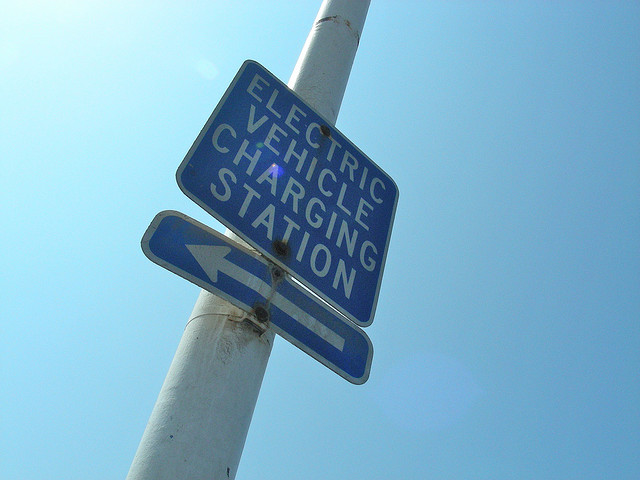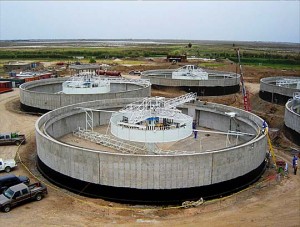Archive for April, 2011
NY Water Treatment Plant Goes Solar
Binghamton, NY received a new 50 kilowatt photovoltaic system at their water treatment plant. The solar panel array is expected to supply more than 10 percent of the city water treatment plants total demand.
This is the city’s first on-site renewable energy generator. The system is composed of 18 arrays with a total of 204 photovoltaic modules. Earthkind Solar of Kingston NY built and installed the panels.
A federal Recovery Act grant from the New York State Energy Research and Development Authority paid $300,000 plus the city’s taxpayers paid $56,000 for the system. It is estimated to save the taxpayers $576,000 over the next 25 years. The array will not only cut the expenses for the city but also shrink the city’s carbon footprint by 23 tons per year.
The water treatment process removes pollutants and helps keep our waterways clean. The treated water is then released into a local river or the ocean.
Many wastewater treatment plants across the country are already online with a solar panel array, or are making plans to install their own photovoltaic systems. Cities in Colorado, California, Texas and West Virginia to name a few.
Nashua Fire Department Re-Usable Roof
Nashua New Hampshire, high school students design and build a re-usable roof for the Nashua  Fire Department at their fire rescue training facility at the city landfill.
Fire Department at their fire rescue training facility at the city landfill.
Nashua high school administrators approached the fire department with an offer to let the students work on the fire department building. The students designed a reusable 48 square foot box that fits inside one of the four hatches on the gabled roof.
Five students in the building construction class showed up this Saturday at Four Hills landfill and installed shingles on the roof they had moved from their school. A crane will set the roof on top of the 3 story concrete building later this month.
The structure is used for training for Nashua and other area firefighters who regularly set the building on fire.
The new design’s replaceable openings can be changed out, so when the firefighters ventilate for smoke and gas by axing their way through the ceiling, only the reusable boxes will need to be replaced.
Replacing the roof has cost the city $10,000 to $15,000; the new design will cost approximately $3,500 to rent the crane and materials.
Solar Panel Carports for Industry, California

Image via Wikipedia
The city of Industry in California is making plans to build solar paneled carports, and electric car charging stations at the Metrolink public transportation station.
The plan is for 1,000 carports, which would have space for 500 cars in the northwest corner of the parking lot. Southern California Edison will purchase power from the 2 megawatts of power generated by the photovoltaic solar panels.
The Industry City Engineer, J.D. Ballas, said the city signed an agreement with Southern California Edison which will purchase power produced by the solar array for 20 years.
The electric car charging station will also be included in the planning of the Foothill Transit 5 story park and ride structure. The charging station will not use the solar power generated by the carport panels, but will instead be powered by a separate source to accommodate for rainy or overcast days.
The 1.2 million dollar project is being built with the cities general fund. Bids for the project are being accepted now for construction to begin this summer with a projected completion date of February 2012.
$11 Million Solar Project at Cincinnati Zoo

Nearly 4 acres of solar panels have been installed on parking canopies at the Cincinnati Zoo and Botanical Gardens. The zoo project is the nation’s largest solar display available to the public.
The solar project took approximately 3 months to complete. Workers installed the last solar display on Friday.
All the engineers, contractors and subcontractors for the zoo project are based in Cincinnati. The major components of the solar canopy were made locally or in other U.S. locations to help promote economic growth.
800 of the 1,000 parking spaces at the main entrance is expected to provide 20% of the zoo’s yearly power needs, and some days sending power back to the utility company.
Melink Corp., the developer and owner of the million dollar project was supported by PNC Bank, Uptown Consortium, National Development Council and First Energy Solutions. As part of the agreement, Melink Corp. will fund 10 scholarships for area residents to be trained as solar equipment installers. The zoo did not have to pay for any of the project.
The project is expected to save hundreds of thousands of dollars in electrical costs. The zoo also has the option to buy the system after seven years.
The zoo has used other energy saving devices since 2006 when the Cincinnati Zoo pledged to construct only sustainable buildings that meet LEED certification requirements. Leadership in Energy and Environmental Design is a third-party certification program and the nationally accepted benchmark for the design, construction and operation of high-performance green buildings.
Existing buildings have been updated with energy efficient products; by switching to energy-efficient LED bulbs for the annual festival of lights has cut energy bill in half.
Zoo visitors can visit the educational kiosk near the zoo’s go-green garden to learn about the technology and benefits of solar energy.
Renting School Rooftops

Image via Wikipedia
Tucson Electric Power Company may have one option for the budget crisis in our public schools. They are offering the “Bright Roofs Program” to the school systems in Tucson, Arizona. TEP is proposing to lease school and other public building rooftops to develop new grid connected solar panel systems.
The goal is to help participating schools save money on energy costs and put the savings back into the classrooms. By allowing the TEP to rent the rooftops for the solar panels, the schools will be able to generate additional money. One high school with a 20,000 square foot flat roof can generate enough electricity for 170 homes. The solar arrays can be installed without making holes in the roof, thereby decreasing any chance of roof damage.
Kohl’s department store is participating in a similar program where SunEdison pays for the solar panels, installation and upkeep and then sells the electricity generated back to kohl’s at or below cost of grid power.
The Obama administration is providing millions of dollars in stimulus payments for “Modernization, energy efficiency and the use of alternative sources of energy“. If the school districts and solar or power companies can participate to find ways to take advantage of the stimulus and tax dollars available for “green roofing” it appears it would be mutually beneficial.
Our education system is in trouble, with budget cuts and increase in population, it’s clear we need to find alternative methods to keep our school doors open. By using the resources the schools already have, such as flat rooftops available to lease to the power companies for solar grid systems. The schools can save money on energy costs, reduce their carbon output, generate a few dollars to go back into the classroom, offer clean energy for the neighborhoods, and provide a unique learning environment for the students.







